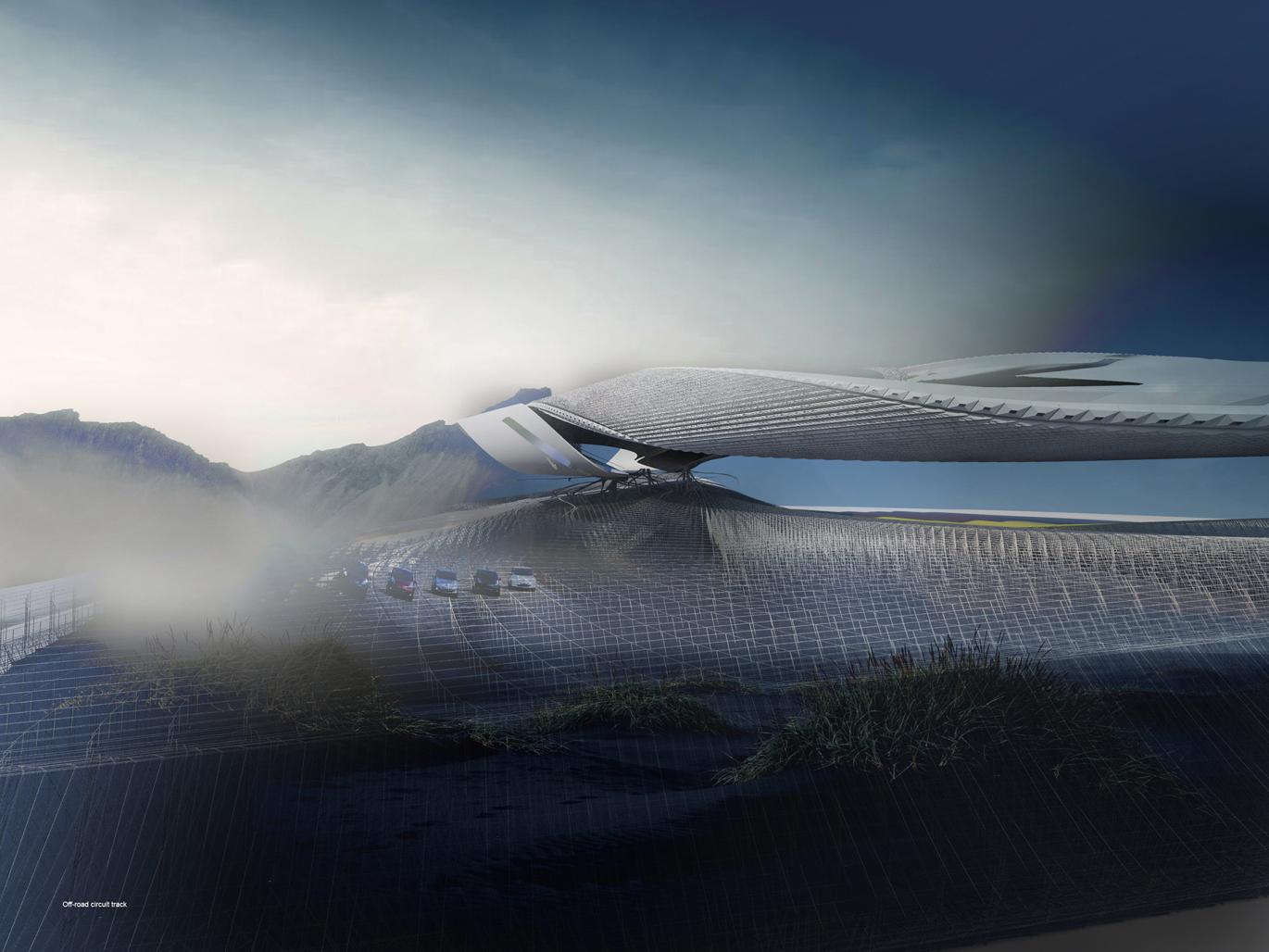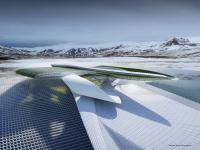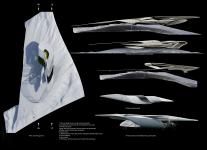The site location is in the South Gobi Desert of Mongolia, 80 kilometers north of Mongolia's border with the People's Republic of China, 100km from Khanbumbat Airport in the province of Khanbogd, Ömnögovi, and 10km from lake Buir.
The design strategy is for the building to respond to site climate merging with its immediate environmental changes.
The design gives the impression of being blown on-site by desert winds, rising out of the landscape when in use, and will be buried under snow and sand when lying dormant. The buried desert building activates with motion.
Rolling sands of the Gobi desert unveil landscapes reconfiguring the topology. The building captures this transformation by being revealed and covered by the sands as it sits low into the sedimentary rock, a fossil-like presence, a relic awaiting discovery. The scheme is a year-round proving ground for off-road testing for new model vehicles with viewing tunnels, flooded areas, and various surface and ground gradients to test the limit of the car's engineering. The design sponsored by SIAC cars accommodates three zones, torsional obstacles, twist tracks, surface response, and skid slopes for endurance; viewing and facilities; and artificial hydroplane flooded and frozen zones. The building is an artificial landscape simulating environments using solar and piezoelectric engineering to mimic different driving conditions. Road surfaces testing break and grip function include snow, ice, wet and dry asphalt, and functional and endurance testing grounds.
The primary structure is an extruded barrel vault partly submerged into the desert rock, functioning as a cooler subterranean environment containing part of the race track, skid circle pads, hydroplane, and testing facilities. A cantilevered ramp projects from the primary structure; it circulates the site using hydraulics to slide into the landscape to alter the track gradient and driving conditions, which can be flooded and frozen. The site's climate and environment change daily as the Mongolian desert temperatures can vary from -30 to 38 degrees Celsius. The building acts and responds like a barometer adapting and providing the proving ground with artificial environments to facilitate testing. The architecture ignites with car motion, awakening in the desert using motion activation sensors; every vehicle is fitted with sensors to activate areas of the track and proving ground, and a single car reanimates the building.
A hydroplane area located around the track on the ground plane freezes part of the primary structure, making use of the nearby reservoir; a refrigeration system for polished ice surfaces cooled using solar generators that line the looped race track generates a maximum capacity of 50KW. The building partly freezes and thaws, mimicking climate according to the season but can also simulate artificial environments throughout the year when needed.
Viewing galleries in tunnels run alongside and below the tracks so that cars are in 3d at all times. Cameras trace the movements as the building becomes an infrastructure merging landscape, vehicle, and program/building.
The looped track rises from the primary structure projecting over the hydroplane; the loop simulates off-road conditions with break tests and surface transitions, descending onto the ground plane it unfolds onto the skid pool and a road winding around the entire site. The looped road/surface can hydraulically expand to slide into the landscape, increasing the terrain to 2km. The loop track uses pre-cast sections that can be replaced according to the vehicle's traction, suspension, and break testing needs. Surfaces include potholes, deep sand pits, gravel, rumble strips, sine waves, undulating asphalt, and cobblestoned road sections. These track sections are supported hydraulically to alter the road gradient depending on testing needs. As the loop track dislocates and slides along the primary structure, it descends onto the landscape to reveal a glass atrium.
The intention was to make the building look monolithic as if sculpted out of desert rock, partly hidden to be discovered, activated, and animated.
2022
Official name of the project: Sand drift proving ground
Location: province of Khanbogd, Republic of Mongolia
Client: SIAC, Inner Mongolia, China
Architects/Designers: Margot Krasojević
Project manager: Margot Krasojević
Collaborators: Out to tender
1. Composite carbon fibre reinforced Polymer composite interior vaulted shell cladding. Elite Carbon Fibre manufacturers, U.k/Beijing
2. Anti-vibration vacuum bagged composite fibre shell insulation, placed between interior and exterior frame.
3. Epoxy laminate molds for fibre glass construction. pressure sensitive tapes for brake testing facility- Matrix composites, U.K./Beijing
4. Technical textiles applied to inner lining of cantilever cladding, lighter than alluminium for weightlessness and resilience. Textile fibre materials determine stability through 45 degree torsions for track expansion. The material adapts to the external forces of the cantilever and it's movement. carbon fibre basic material. Carbon fibre reinforced plastics allow for complex shapes more than steel or alluminium. weight saving. resin saturated cured elements, achieving lower weight for the cantilever.
5. 3m optical mirror film, light transmission. polymer film exhibits 99% light reflectance for interior and exterior cladding elements used in viewing tunnel and atrium surfaces.
6. Interior materials. Polyester films transforming between transparent and translucent states dependant on viewing angles, anti-reflective privacy films.
7. Self healing polymers used to support internal mechanisms, sliding seemless surfaces and load transfer attachments between skin and skeleton of expanding race track.This structural deforminty under load catering the telescopic composite fibre sections has a series of polymer sheeths which protect the design from wear and tear as the tracks slide apart to reveal the atrium.
8. Motion capture system, between the primary and tertiary structure record the movements of vehicles, which allows the facility to virtually synchronise with vehicle movement and performance.
9. Concerns ranged from contaminated areas on the desert subrock amd sand deposit pollutants; the docking areas into which vehicles are locked, weighted and cantilevered need to be arranged in a manner which defines the testing track ground planes length; the elevated race tracks precast concrete external shells need to be soundproofed as well as strong and flexible enough for load, transit and expansion. Cross ventilation, truss or monococque structure, corrosion resistant and fire resistant cladding materials were invesitgated extensively.
10. Light transmission is very important in the viewing tunnels and barrel vaulted facility which is why acrylic is beneficial to the design along with PLEDS, enabling thin lighitng displays with superior effect and simplicity to LCD'S. These Polymer Light Emitting Diodes are also used in the surrounding landscape of the proving ground to transform the interior environment as necessary.
11. Telescopic track shell sections lined with composite carbon fibre impregnated with epoxy resin.
12. Brake meausrement tracks, surfaces include Asphalt, Tiles, polished basalt, concrete Aquaplaning basin/Hydroplane.
13. Inflatable manoueverinhg kerb strike installation. Kerb facilitates shallow angle strikes and steering ‘jacking’ off the kerb. located around the race track and crash zone.
14. 1km of surface textures, potholes, rough road tracks put suspension and electronics through a hard test. The track provides different road surfaces and is suitable for speeds up to 60 km/h.
Rumble strips: three 2.4 m / 8 ft x 2.7 m / 9 ft strips
Deep sand: 91 m / 300 ft x 6 m / 20 ft
Gravel: 141 m / 470 ft x 15 m / 50 ft
Sine waves: 30 m / 100 ft x 6 m / 20 ft
Potholes: 3 m / 10 ft x 21.3 m / 71 ft with 6 potholes 1 – 1 1/2” deep
15. 1KM elevated Sine wave track for vehicle suspension
16. 2KM Hydroplane ground circulates the project.
17. IKM of cold-weather vehicle test tracks offer controlled conditions for driven tests in a cold environment with or without a low friction surface at a maximum of 100km/h
Margot Krasojevic
Favorited 3 times










